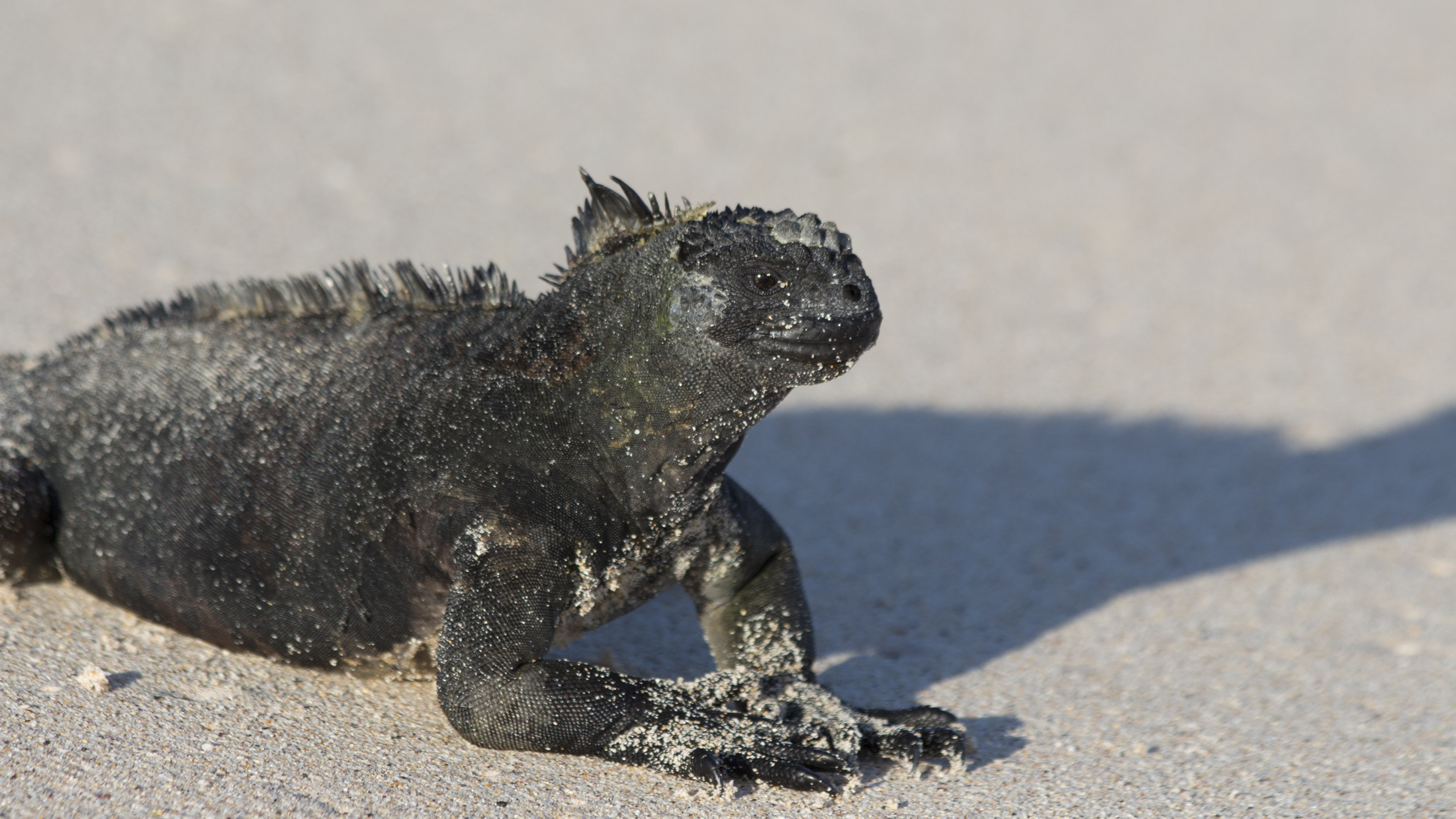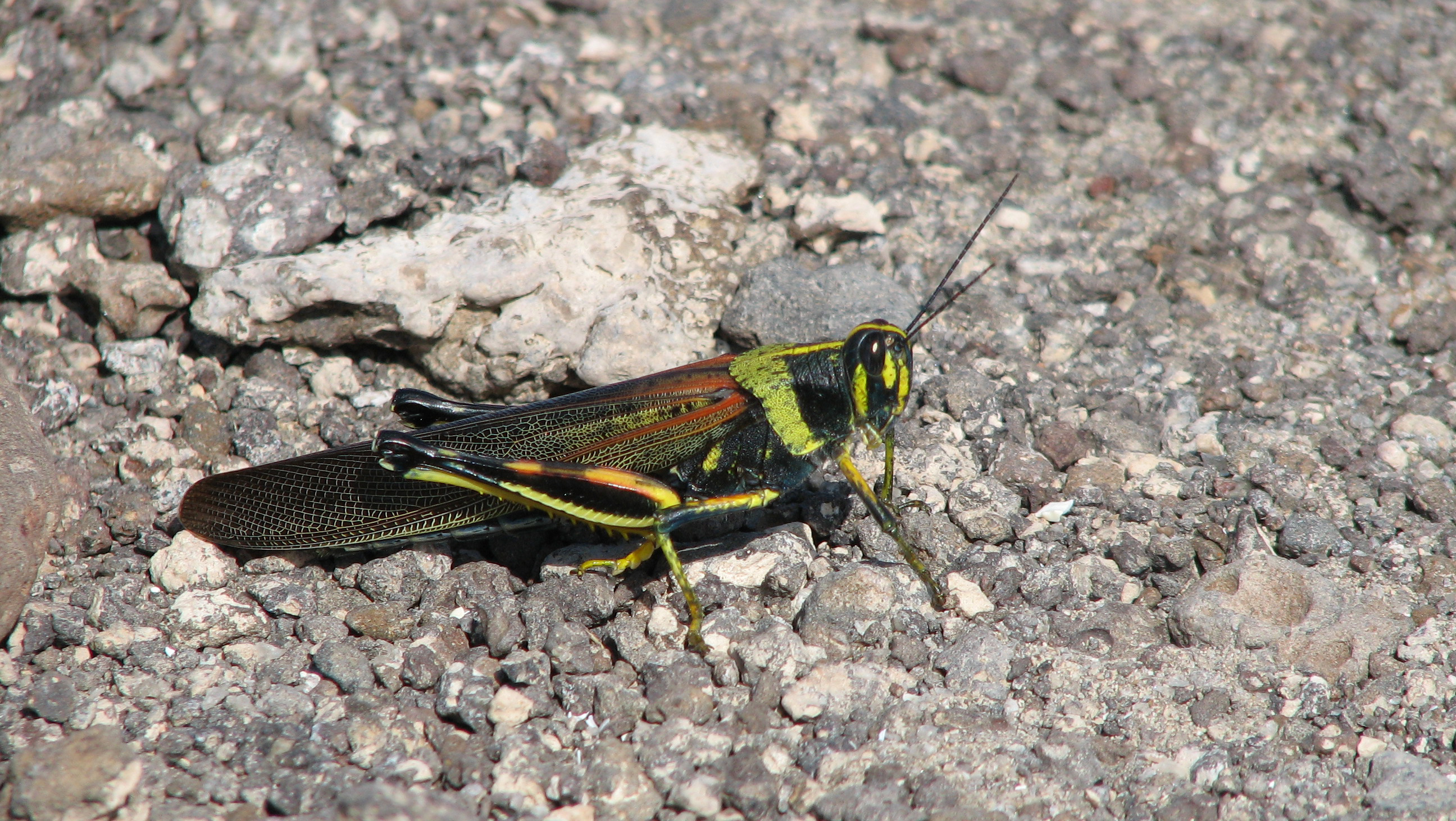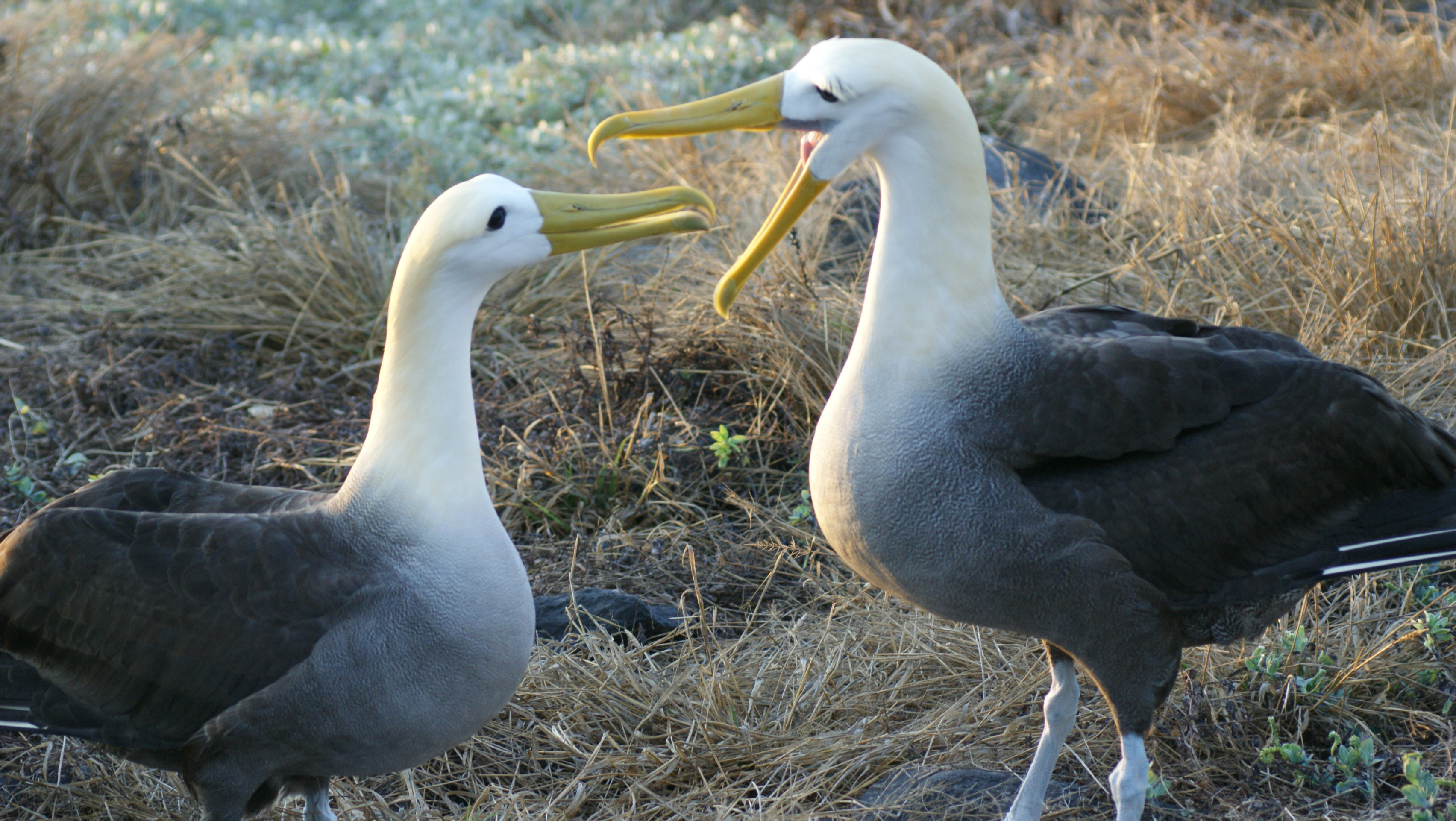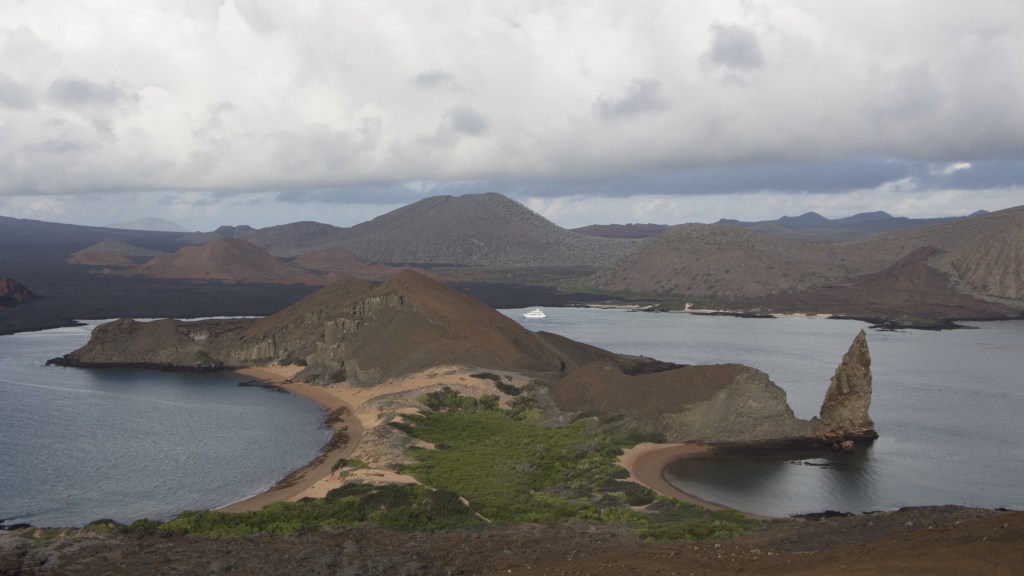Your childhood science textbooks lied to you — finches and giant tortoise aren’t the coolest species in the Galapagos Islands.
Now that’s not to say that these classic Galapagos species aren’t cool — both groups are undeniably awesome. But this archipelago has a lot more to offer a naturalist than just these often-hyped examples. Try these: Pink iguanas, giant daisy trees, lava-loving cacti, and painted locusts, anyone?
Here are our picks for awesome non-finch, non-tortoise species from The Enchanted Isles.
Top 10 List
-
Opuntia Cacti

Opuntia echios var. gigantea on Isla Santa Cruz. Photo © Dallas Krentzel / Flickr through a Creative Commons license. Anyone who’s ever hiked in cactus country can respect the clout of the prickly pear. But what if that cactus was the size of a tree? Meet Opuntia echios, one of six Opuntia species (with 14 varieties) in the Galapagos. Descendants of prickly pear cactus from the mainland, these cacti get big. Very big. Mature plants can reach nearly 40 feet high. Thankfully for everyone, the mature plants lose most of their spines around their central trunk as they age.
-
Galapagos Mockingbirds

Mimus parvulus, the Galapagos mockingbird. Photo © Justine E. Hausheer History buffs know that it was mockingbirds — not finches — that captivated Charles Darwin. Darwin collected hundreds of specimens on his one-and-only trip to the Galapagos, and it was the subtle differences between the mockingbirds that helped him realize that species might change over time. Fortunately, Darwin labeled which dead mockingbird came from which island — something he failed to do with the finches. Whoops.
Scientists have since sorted out that are four species of mockingbirds in the Galapagos. Like the finches they look absurdly similar, which is a real credit to Darwin’s powers of observation. The Galapagos mockingbird, Mimus parvulus, is the most common and is found on most major islands. The other three species — the Charles, Hood, and Chatham mockingbirds — are found exclusively on a handful of the archipelago’s smaller southern islands.
-
Land Iguanas

Galapagos land iguana, Conolophus subcristatus, on Isla Isabela. Photo © Justine E. Hausheer Yes, I’m aware that the Galapagos has marine iguanas… we’ll get to them in a minute. But their land-bound cousins are pretty cool, too. There are three species of Galapagos land iguana, including a mysterious species of pink — yes, pink — iguana found only on the summit of Isla Isabela’s Volcán Wolf. The species was first sighted in 1986, but remained entirely unstudied until 2009.
DNA analysis shows that today’s marine and land iguanas likely evolved from a common ancestor, diverging about 10 million years ago or more. But the Galapagos islands are only about 5 million years old. Do the math and it’s pretty clear that something’s off. That’s because both Galapagos iguanas started evolving before today’s islands even existed. How is that possible? Like Hawaii, the Galapagos islands are formed by a volcanic hotspot beneath a tectonic plate. It’s likely that the iguana split occurred on older, now-submerged islands that moved off the hotspot and eroded below the ocean’s surface.
-
Marine Iguanas

Galapagos marine iguana on the beach on Isla Santa Cruz. Photo © Justine E. Hausheer Marine iguanas are right up there with finches, tortoises, and boobies on the list of Galapagos critters most likely to make it onto a touristy t-shirt. So why did they make this list? Because they can shrink themselves. Two scientific studies found that marine iguanas can shrink their body size by as much as 20 percent (6.8 centimeters) when food supplies crash during El Nino years. Though scientists aren’t exactly sure how this happens, they suspect that the iguanas literally reabsorb their own bones to survive, accounting for the shrinkage. As if looking like Godzilla, eating algae, snorting salt, and being the only swimming lizard in the world weren’t cool enough.
-
Lava Cactus
Brachycereus nesioticus

Brachycereus nesioticus on a lava flow on Isla Genovesa. Photo © Justine E. Hausheer Think Opuntia are the only cool cactus in the Galapagos? Think again. The lava cactus is one spiffy succulent. The smallest of the Galapagos cacti, this species evolved to colonize recent lava flows. In fact, that’s the only place it grows. The spines on newly-grown lava cactus stems are yellow, and then fade to grey as the plant ages. This cactus does flower, but the cream-colored blossoms open at night and shrivel within a few hours.
-
Galapagos Penguin
Spheniscus mendiculus

A Galapagos penguin preens on coastal lava. Photo © Justine E. Hausheer Galapagos penguins win the adorable avian award for Galapagos wildlife. But they also add a special touch of weirdness — any place where you can see penguins swimming beneath a volcanic cliff dotted with cacti is high on the weird-but-true nature scale.
These birds get a lot of love for being the only penguin species to live North of the Equator, if just barely. But they’re also the rarest penguin species in the world — only about 2,000 individuals live mostly on the western edges of the westernmost islands, where the Cromwell current keeps the water temperatures cool.
-
Large Painted Locust
Schistocerca melanocera

Galapagos large painted locust. Photo © NH53 / Flickr through a Creative Commons license. Compared to mainland South America, the Galapagos are about as colorful as a funeral. Most flowers are white and yellow, and most birds are black or brown. But hidden amid the vegetation is an insect with awesome lime green and burnt orange hues — the large painted locust. Often spotted on low vegetation or lava rocks, these 3-inch-long insects are an important food source for Galapagos hawks and lava lizards.
-
Scalesia Plants

Radiate-headed scalesia (Scalesia affinus) at Tagus Cove, Isla Isabela. Photo © Justine E. Hausheer Darwin’s finches are the poster child for evolution in the Galapagos and elsewhere, but the Scalesia genus is arguably the better example of adaptive radiation on the islands. Case in point: the 15 species in the Scalesia genus, all of which are endemic to the Galapagos, are members of the daisy family, Asteraceae. Upon arriving in the islands these plants evolved into different species occupying vastly different ecological niches — a classic example of adaptive radiation.
Take Scalesia pedunculata, a 50-foot tall tree that forms extensive woodland forests in the highland zones of four larger islands. The species has earned the inevitable nickname of “daisy tree.” While S. pedunculata certainly doesn’t look anything like your common lawn daisy, they’re related.
-
Lava Lizard species

Microlophus albemarlensis on Isla Santa Cruz. Photo © Justine E. Hausheer There are seven species of lava lizard in the archipelago, with the most common being Microlophus albemarlensis, the Galapagos lava lizard. These little reptiles are often seen skittering across — you guessed it — lava rocks. Given that the Galapagos are an entirely volcanic archipelago that’s not surprising. But there is something fun about watching a crimson-necked male lizard doing “push-ups” to impress the ladies on top of some recent pahoehoe lava. (Just tell me that’s not an example of convergent evolution.)
-
Waved Albatross
Phoebastria irrorata

Waved albatross court on Isla Espanola. Photo © Tim Ellis / Flickr through a Creative Commons license. Waved albatross aren’t strictly endemic to the Galapagos, but since virtually the entire world population (all but 10-20 pairs) nests on Isla Española, we’re going to let that technicality slide. These critically endangered albatross are best known for their absurd, hilarious, and endearing courtship ritual. The male and female albatross, which mate for life, re-bond each year with an unfathomably complex series of head bobbing, bill clacking, and sky-pointing.
The pair then lay their egg right on the ground. When the chick hatches, its parents will travel as far as 62 miles away from the nest to supply chicks with meals of squid, fish, and crustaceans. Like other albatross, this species uses dynamic soaring to fly for hours without ever flapping its wings.




Join the Discussion